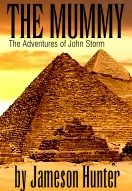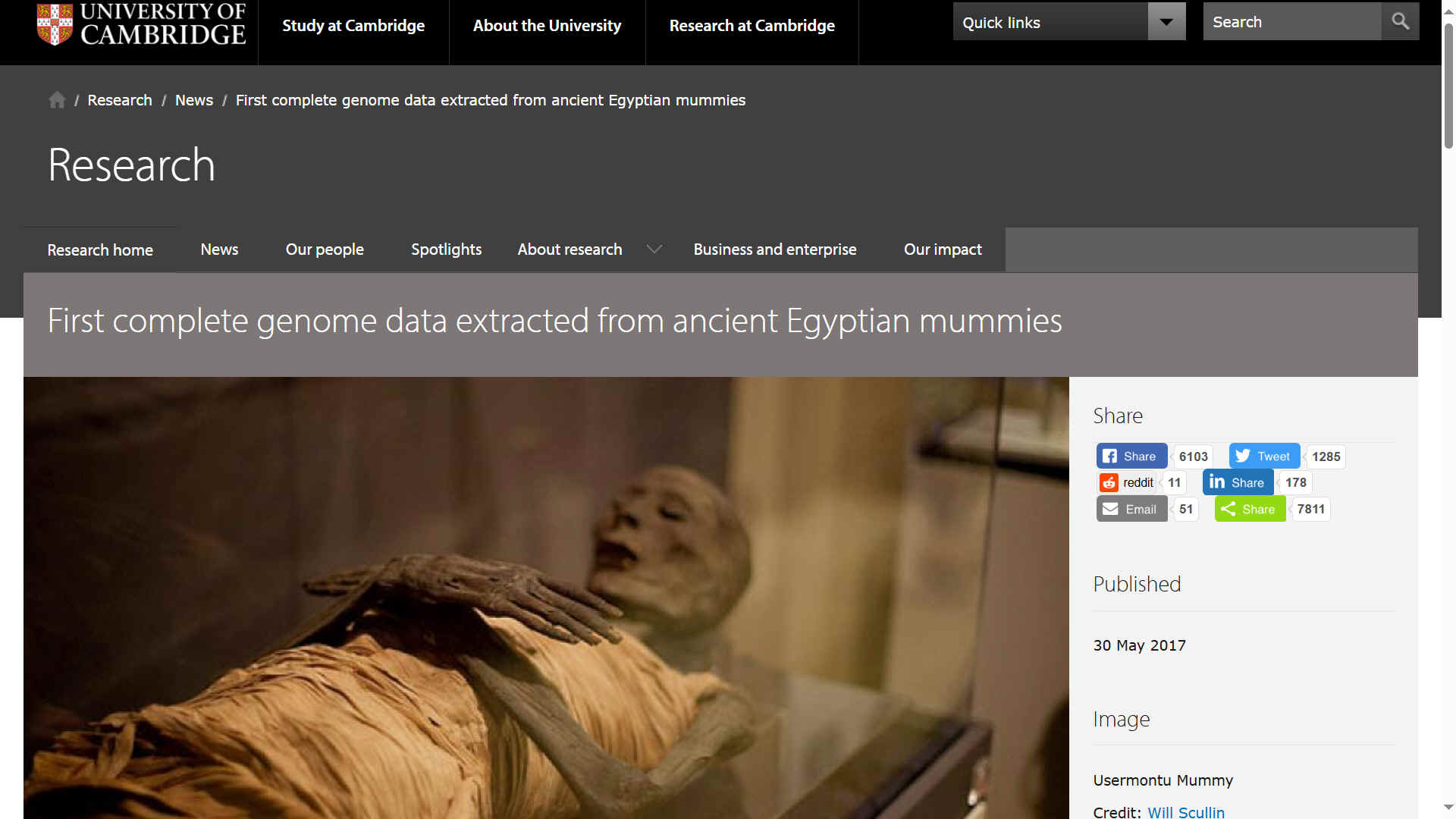
Study finds that ancient Egyptians were most closely related to ancient populations from the Middle East and Western
Asia
An international team of researchers have successfully recovered and analysed ancient DNA from Egyptian mummies dating from approximately 1400 BCE to 400 BCE, including the first genome-wide data from three individuals. The study found that modern Egyptians share more ancestry with sub-Saharan Africans than ancient Egyptians did, whereas ancient Egyptians were found to be most closely related to ancient people from the Middle East and Western Asia.
This study counters prior scepticism about the possibility of recovering reliable ancient
DNA from Egyptian mummies. Despite the potential issues of degradation and contamination caused by climate and mummification methods, the authors were able to use high-throughput DNA sequencing and robust authentication methods to ensure the ancient origin and reliability of the data. The study, published in the journal Nature Communications, shows that
Egyptian
mummies can be a reliable source of ancient
DNA, and can contribute to a more accurate and refined understanding of Egypt’s history.
Egypt is a promising location for the study of ancient populations. It has a rich and well-documented history, and its geographic location and many interactions with populations from surrounding areas, in
Africa, Asia and
Europe, make it a dynamic region. Recent advances in the study of ancient DNA present an opportunity to test existing understandings of Egyptian history using ancient genetic data.
However, genetic studies of ancient Egyptian mummies are rare due to methodological and contamination issues. Although some of the first extractions of ancient DNA were from mummified remains, scientists have raised doubts as to whether genetic data, especially the nuclear DNA which encodes for the majority of the genome, from mummies would be reliable, and whether it could be recovered at all.
“The potential preservation of DNA has to be regarded with scepticism,” said Johannes Krause, Director at the Max Planck Institute for the Science of Human History and senior author of the study. “The hot Egyptian climate, the high humidity levels in many tombs and some of the chemicals used in mummification techniques, contribute to DNA degradation and are thought to make the long-term survival of DNA in Egyptian mummies unlikely.”
For this study, the team, led by the University of Tübingen and the Max Planck Institute for the Science of Human History in
Germany, and including researchers from the University of Cambridge, looked at genetic differentiation and population continuity over a 1,300 year timespan, and compared these results to modern populations.
The team sampled 151 mummified individuals from the archaeological site of Abusir el-Meleq, along the
Nile River in Middle
Egypt, from two
anthropological collections hosted and curated at the University of Tübingen and the Felix von Luschan Skull Collection at the Museum of Prehistory of the Staatliche Museen zu
Berlin, Stiftung Preussicher Kulturbesitz.
In total, the authors recovered partial genomes from 90 individuals, and genome-wide datasets from three individuals. They were able to use the data gathered to test previous hypotheses drawn from archaeological and historical data, and from studies of modern DNA.
“In particular, we were interested in looking at changes and continuities in the genetic makeup of the ancient inhabitants of Abusir el-Meleq,” said Alexander Peltzer, one of the lead authors of the study from the
University of Tübingen.
The team wanted to determine if the investigated ancient populations were affected at the genetic level by foreign conquest and domination during the time period under study, and compared these populations to modern Egyptian comparative populations.
“There is literary and archaeological evidence for foreign influence at the site, including the presence of individuals with Greek and Latin names and the use of foreign material culture,” said co-author W. Paul van Pelt from Cambridge’s Division of Archaeology. “However, neither of these provides direct evidence for the presence of foreigners or of individuals with a migration background, because many markers of Greek and
Roman identity became ‘status symbols’ and were adopted by natives and foreigners alike. The combined use of artefacts, textual evidence and ancient DNA data allows a more holistic study of past identities and cultural exchange or ‘entanglement’.”
The study found that the inhabitants of Absur el-Meleq were most closely related to ancient populations in the Levant, and were also closely related to
Neolithic populations from the Anatolian Peninsula and Europe. “The genetics of the Abusir el-Meleq community did not undergo any major shifts during the 1,300 year timespan we studied, suggesting that the
population remained genetically relatively unaffected by foreign conquest and rule,” said Wolfgang Haak, group leader at the Max Planck Institute for the Science of
Human
History, and a co-author of the paper.
The data shows that modern Egyptians share approximately 8% more ancestry on the nuclear level with sub-Saharan African populations than the inhabitants of Abusir el-Meleq, suggesting that an increase in sub-Saharan African gene flow into Egypt occurred within the last 2,000 years. Possible causal factors may have been improved mobility down the
Nile
River, increased long-distance trade between sub-Saharan Africa and Egypt, and the trans-Saharan slave trade that began approximately 1,300 years ago.
REFERENCE
Verena J. Schuenemann et al. ‘Ancient Egyptian mummy genomes suggest an increase of Sub-Saharan African ancestry in post-Roman periods.’ Nature Communications (2017). DOI: 10.1038/ncomms15694
Adapted from a press release from the Max Planck Institute for the Science of Human History.
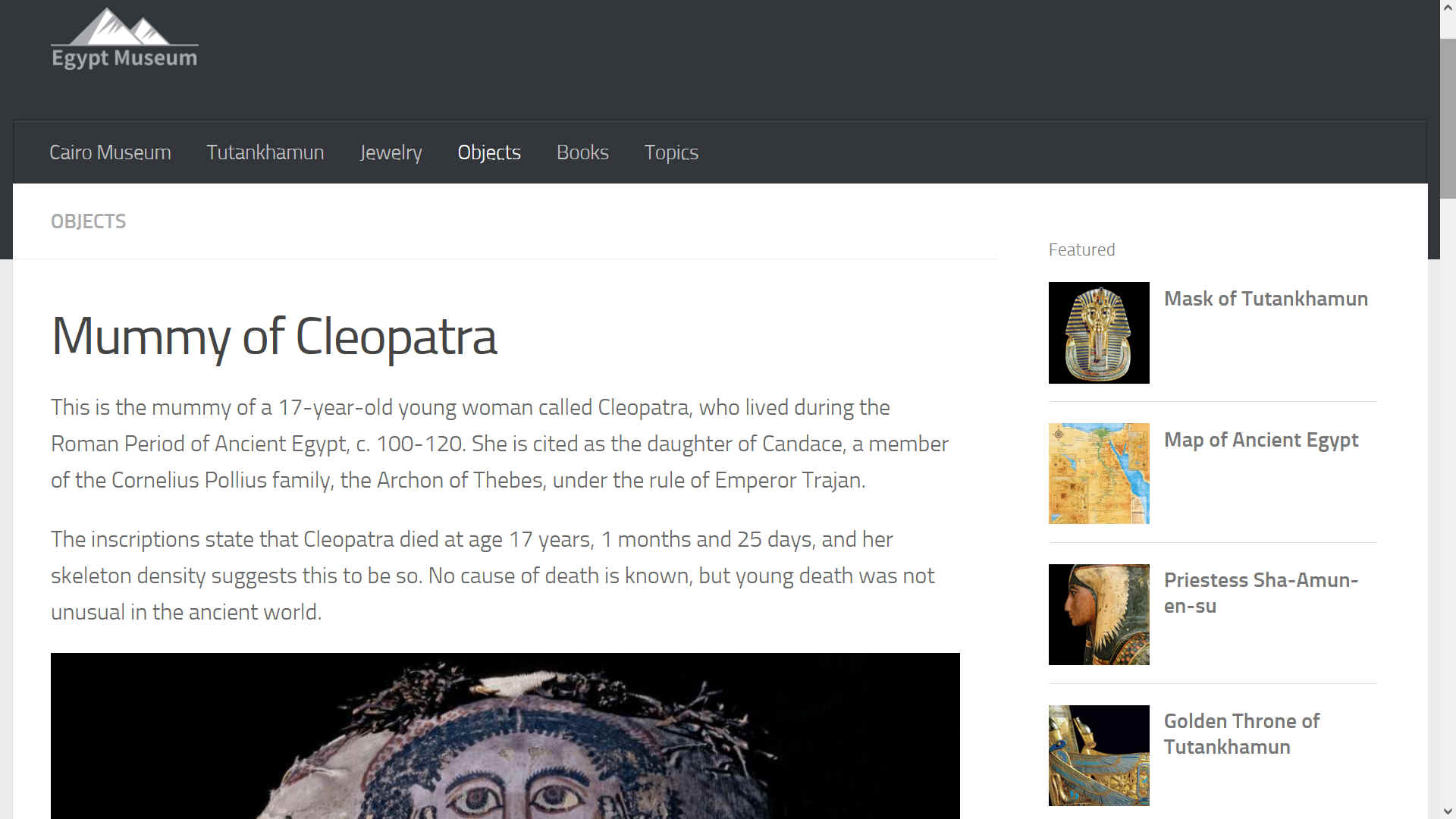
The mummy of Cleopatra, who now reigns in the Egyptian section in the British Museum of London, is one of those immortal objects. Many people think that this mummy is the mummy of the
famous Cleopatra, Queen of Egypt, who committed
suicide bitten by
an asp. But this is a big mistake: she's not the Cleopatra we know from the movies though one might hope she is a member of the same family who lived in II century AD. All of
Cleopatra
VII's siblings were
executed by the Romans, specifically to prevent any comeback and challenge
to Rome.
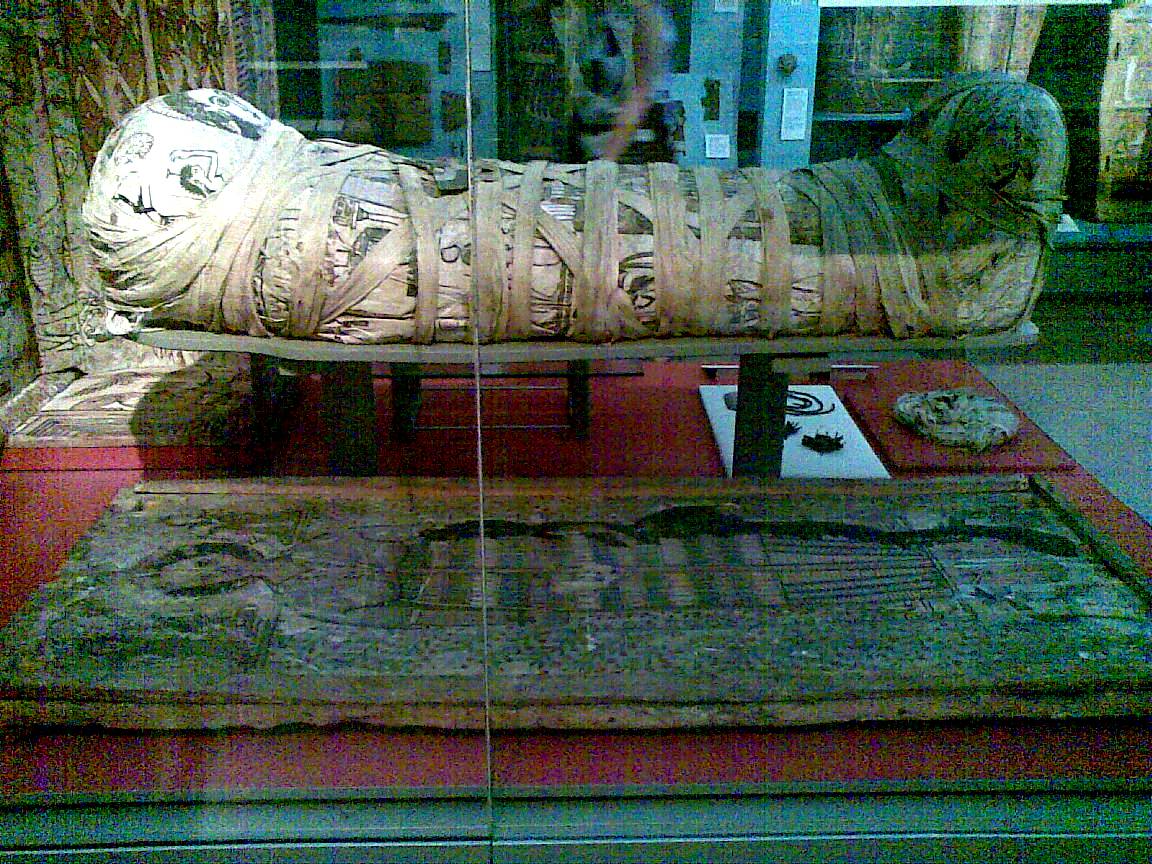
Here
y
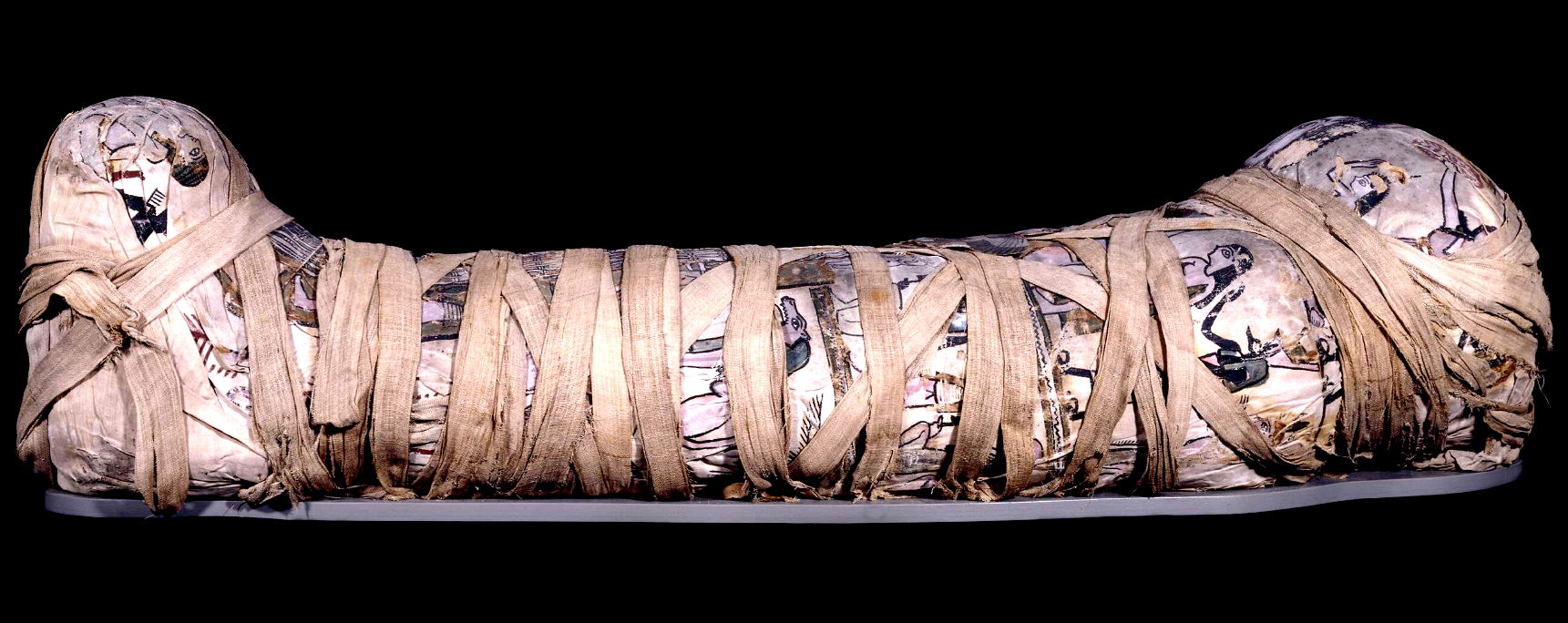
BRITISH
MUSEUM WRITE UP
Mummy of
Cleopatra, daughter of Candace, a member of the family of Cornelius Pollius, Archon of Thebes in the time of the Emperor Trajan. The inscriptions on her coffin state that she died at the age of 17 years, 1 month and 25 days (an earlier reading of the age as 11 years is now discarded, as the developmental state of the skeleton indicates death in late teens). The body is wrapped in fine linen bandages with an outer shroud, secured by bandages crossing diagonally and horizontally, decorated with a polychrome painted full-length representation of Nut, flanked by other deities, including Isis, Nephthys and Anubis, with a wooden comb, a string of berries and the remains of a funerary wreath lying on top of the mummy.
Body and Limbs - Very little can be observed in this mummy owing to dense material, probably plaster, under the bandages. The ribs and bones of the arms and legs can be seen to have no fractures. There is an indeterminate opacity in the body-cavity. The arms are extended, the palms of the hands in contact with the outer aspect of the thighs. the left hip is dislocated, probably the result of tight bandaging. No lines of arrested growth.
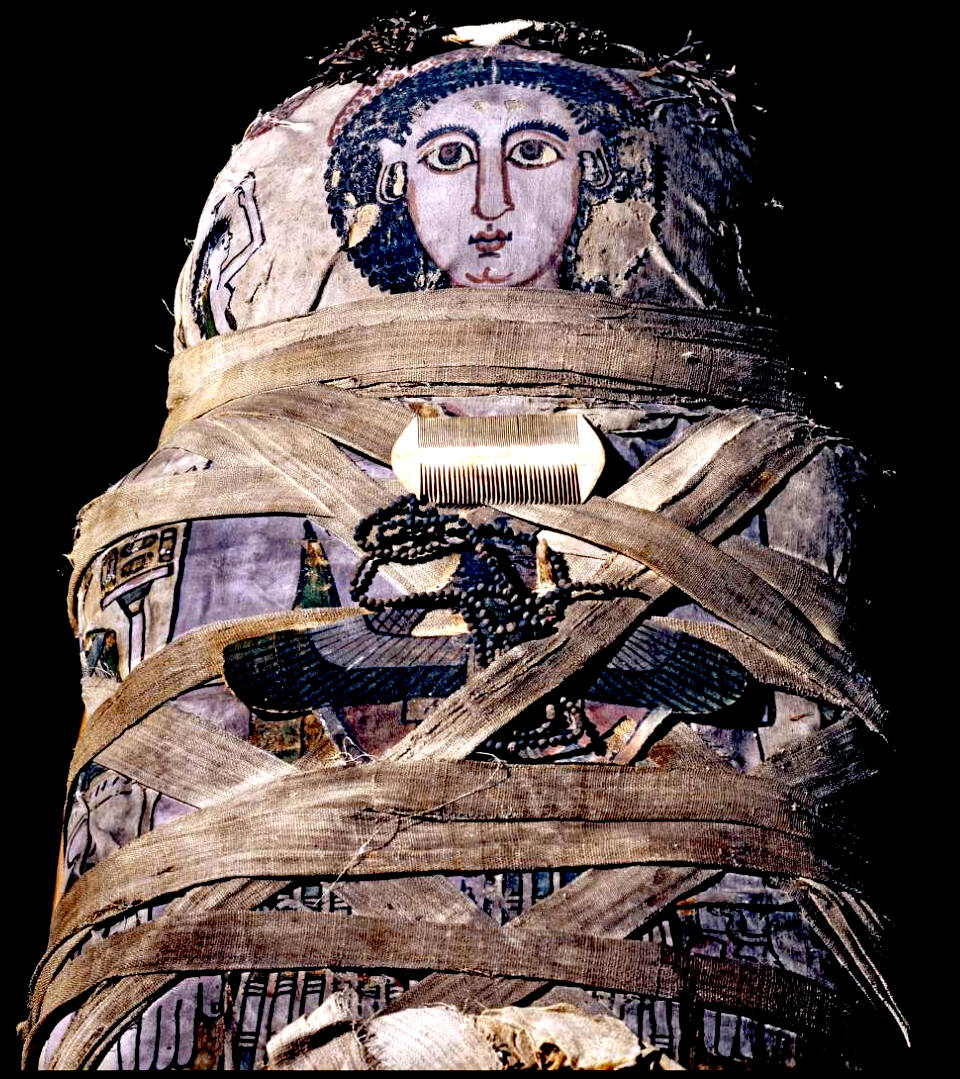
Found
MEDIA
INDEX
BBC
NEWS - NETFLIX CLEOPATRA DOCUDRAMA 10 MAY 2023
BRISBANE
TIMES - RADAR REVEALS POSSIBLE LOCATION CLEOPATRA'S TOMB 2009
BRITISH
MUSEUM - CLEOPATRA,
17 YEAR OLD DAUGHTER OF CANDACE, THEBES
CAMBRIDGE
UNIVERSITY - STUDY
OF ANCIENT EGYPTIAN MUMMY DNA 17 MAY 2017, RELATED TO MIDDLE EAST
CBC
- CLEOPATRA OUTSMARTED EVERYONE, FEBRUARY 2021
CBS
- WHY
SOME EGYPTIANS ARE FUMING OVER NETFLIX'S BLACK CLEOPATRA
DAILY
MAIL - ADELE JAMES BREAK SILENCE AS TO BLACKWASHING CLAIMS MAY 2023
DAILY
MAIL - DEC
9 2024 KATHLENE MARTINEZ SEARCHING 20 YEARS MAKE SIGNIFICANT
FIND
DISCOVERY
MAGAZINE - JUNE
7 2023, WILL WE EVER FIND THE TOMB OF CLEOPATRA?
GREEK
CITY TIMES - ARCHAEOLOGIST CLAIMS TO BE CLOSE TO DISCOVERY OF CLEOPATRA
2021
LIVESCIENCE
- WHERE IS CLEOPATRA'S TOMB/PALACE JULY 2020
NATURE
- STUDY
90 MUMMIES REVEALS ANCESTRY ANCIENT EGYPTIANS: MIDDLE EASTERN JUNE
2017
ROTTEN
TOMATOES - CLEOPATRA
CRITICS, SERIES 1 REVIEWS MAY 2023
SKY
HISTORY - THE
HIDDEN TOMB OF CLEOPATRA MARCH 2023
SKYE
NEVILLE - PLASTIC FREE COMICS, WAITROSE BANS
SMITHSONIAN
- MORE
THAN HISTORIC SEDUCTIONS, REHABILITATED ELIZABETH TAYLOR, HOLLYWOOD ICON:
2010
SPECTATOR
- THE
TROUBLE WITH NETFLIX'S QUEEN CLEOPATRA 29 MAY 2023
THE
CONVERSATION - WHY
THE DISCOVERY OF CLEOPATRA'S TOMB COULD REWRITE HISTORY 2022
THE
GUARDIAN - NETFLIX, NO NEED FOR WHITE ACTOR 10 MAY 2023
THE
SUN - QUEEN CLEOPATRA'S TOMB, TAPOSIRIS MAGNA 2020
THE
SUN - THE REICH STUFF: GLOBAL HUNT FOR HITLER'S LOST £20 BILLION NAZI GOLD HORDE APRIL 2021
UNDERWATER
PHOTOGRAPHY GUIDE - CLEOPATRA'S SUNKEN PALACE
USA
TODAY - MUSTAFA
WAZIRI, ALEXANDRIA, EGYPTIAN ARCHAEOLOGISTS 2018
YOUTUBERS
- MAKEUP,
CLEOPATRA'S FACE & EYE COSMETICS, MUMMY MASK
YOUTUBERS
- NETFLIX VIDEO COMMENTS MAY 2023
ZAHI
HAWASS - DOCUMENTARY: CLEOPATRA VII PHILOPATOR
https://www.cam.ac.uk/research/news/first-complete-genome-data-extracted-from-ancient-egyptian-mummies
https://www.cam.ac.uk/research/news/first-complete-genome-data-extracted-from-ancient-egyptian-mummies

CLONED
REPLICANT - Using the latest technology in computer genome mapping and
digital DNA splicing, an scientists, reincarnate Cleopatra
VII, who died in 30BC, having located her sarcophagus from
its watery grave. The resurrected Pharaoh has to mesh with the modern
world she's been reborn into, against many interested parties, who have
other plans for the former Queen of Egypt.
..
|





